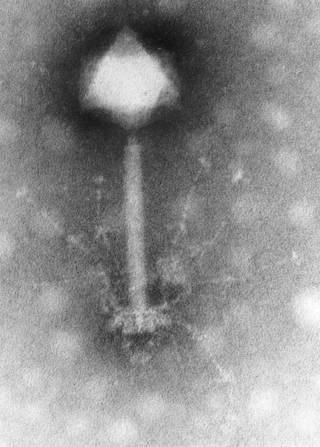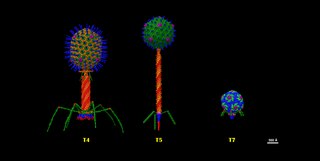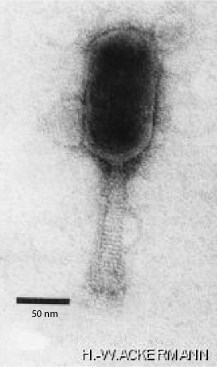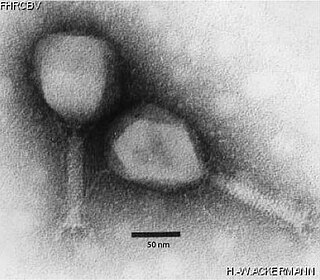
Flaviviridae is a family of enveloped positive-strand RNA viruses which mainly infect mammals and birds. They are primarily spread through arthropod vectors. The family gets its name from the yellow fever virus; flavus is Latin for "yellow", and yellow fever in turn was named because of its propensity to cause jaundice in victims. There are 89 species in the family divided among four genera. Diseases associated with the group include: hepatitis (hepaciviruses), hemorrhagic syndromes, fatal mucosal disease (pestiviruses), hemorrhagic fever, encephalitis, and the birth defect microcephaly (flaviviruses).
Virus classification is the process of naming viruses and placing them into a taxonomic system similar to the classification systems used for cellular organisms.

Mycobacterium is a genus of over 190 species in the phylum Actinomycetota, assigned its own family, Mycobacteriaceae. This genus includes pathogens known to cause serious diseases in mammals, including tuberculosis and leprosy in humans. The Greek prefix myco- means 'fungus', alluding to this genus' mold-like colony surfaces. Since this genus has cell walls with a waxy lipid-rich outer layer that contains high concentrations of mycolic acid, acid-fast staining is used to emphasize their resistance to acids, compared to other cell types.

Myoviridae was a family of bacteriophages in the order Caudovirales. The family Myoviridae and order Caudovirales have now been abolished, with the term myovirus now used to refer to the morphology of viruses in this former family. Bacteria and archaea serve as natural hosts. There were 625 species in this family, assigned to eight subfamilies and 217 genera.

Podoviridae was a family of bacteriophage in the order Caudovirales often associated with T-7 like phages. The family and order Caudoviraleshave now been abolished, with the term podovirus now used to refer to the morphology of viruses in this former family. There were 130 species in this family, assigned to 3 subfamilies and 52 genera. This family was characterized by having very short, noncontractile tails. Many former phages in the former family Podoviriade are now classified in the Autographiviridae

Filamentous bacteriophages are a family of viruses (Inoviridae) that infect bacteria, or bacteriophages. They are named for their filamentous shape, a worm-like chain, about 6 nm in diameter and about 1000-2000 nm long. This distinctive shape reflects their method of replication: the coat of the virion comprises five types of viral protein, which are located in the inner membrane of the host bacterium during phage assembly, and these proteins are added to the nascent virion's DNA as it is extruded through the membrane. The simplicity of filamentous phages makes them an appealing model organism for research in molecular biology, and they have also shown promise as tools in nanotechnology and immunology.

Caudoviricetes is a class of viruses known as the tailed bacteriophages. Under the Baltimore classification scheme, the Caudoviricetes are group I viruses as they have double stranded DNA (dsDNA) genomes, which can be anywhere from 18,000 base pairs to 500,000 base pairs in length. The virus particles have a distinct shape; each virion has an icosahedral head that contains the viral genome, and is attached to a flexible tail by a connector protein. The order encompasses a wide range of viruses, many containing genes of similar nucleotide sequence and function. However, some tailed bacteriophage genomes can vary quite significantly in nucleotide sequence, even among the same genus. Due to their characteristic structure and possession of potentially homologous genes, it is believed these bacteriophages possess a common origin.

A mycobacteriophage is a member of a group of bacteriophages known to have mycobacteria as host bacterial species. While originally isolated from the bacterial species Mycobacterium smegmatis and Mycobacterium tuberculosis, the causative agent of tuberculosis, more than 4,200 mycobacteriophage have since been isolated from various environmental and clinical sources. 2,042 have been completely sequenced. Mycobacteriophages have served as examples of viral lysogeny and of the divergent morphology and genetic arrangement characteristic of many phage types.

Corticovirus is a genus of viruses in the family Corticoviridae. Corticoviruses are bacteriophages; that is, their natural hosts are bacteria. The genus contains two species. The name is derived from Latin cortex, corticis. However, prophages closely related to PM2 are abundant in the genomes of aquatic bacteria, suggesting that the ecological importance of corticoviruses might be underestimated. Bacteriophage PM2 was first described in 1968 after isolation from seawater sampled from the coast of Chile.
Enquatrovirus is a genus of bacteriophages in the order Caudovirales, in the family Podoviridae. Bacteria serve as natural hosts. There is currently only one species in this genus: the type species Escherichia virus N4.
Gordonia is a genus of gram-positive, aerobic, catalase-positive bacterium in the Actinomycetota, closely related to the Rhodococcus, Mycobacterium, Skermania, and Nocardia genera. Gordonia bacteria are aerobic, non-motile, and non-sporulating. Gordonia is from the same lineage that includes Mycobacterium tuberculosis. The genus was discovered by Tsukamura in 1971 and named after American bacteriologist Ruth Gordon. Many species are often found in the soil, while other species have been isolated from aquatic environments. Some species have been associated with problems like sludge bulking and foaming in wastewater treatment plants. Gordonia species are rarely known to cause infections in humans.
Mycobacterium virus Patience, also called Patience, is a bacteriophage that infects Mycobacterium smegmatis bacteria. The large difference between the GC content of this virus's genome (50.3%) and that of its host (67.4%) indicate Patience likely evolved among bacteria of lower GC content but was able to infect M. smegmatis as well. It is the only species of the genus Patiencevirus.

Schizotequatrovirus is a unassigned genus of viruses in the unassigned family Straboviridae, in the class Caudoviricetes,. Bacteria serve as natural hosts. There are three species in this genus.

Tevenvirinae is a subfamily of viruses in the family Straboviridae of class Caudoviricetes. The subfamily was previously placed in the morphology-based family Myoviridae, which was found to be paraphyletic in genome studies and abolished in the 2021 International Committee on Taxonomy of Viruses (ICTV) classification. Bacteria and archaea serve as natural hosts. There are 148 species in this subfamily, included in 14 genera.
Fromanvirus is a genus of viruses in the order Caudovirales, in the family Siphoviridae. Bacteria serve as natural hosts, with transmission achieved through passive diffusion. There are 59 species in this genus.
Mycobacterium virus Jeffabunny is a bacteriophage known to infect bacterial species of the genus Mycobacterium. It was discovered by Jeffrey Rubin in 2008 in a Howard Hughes Medical Institute funded lab as part of SEA-PHAGES. It was taken from surface soil in a planter, in the shade of a non-redwood tree at Merrill College found infecting, specifically, Mycobacterium smegmatis.
Mycobacterium virus Packman is a bacteriophage known to infect bacterial species of the genus Mycobacterium. It is named after the famed arcade game character Pac-Man, from the game of the same name.
Mycobacterium virus D29 (D29) is a cluster A mycobacteriophage belonging to the Siphoviridae family of viruses, it was discovered in 1954 by S. Froman. D29 is notable for its ability to infect M. tuberculosis. D29 is a double stranded DNA mycobacteriophage. It is a lytic phage, this means that D29 takes the lytic pathway of infection instead of the lysogenic pathway of infection. There are no human associated diseases associated with mycobacterium virus D29.

Microbacterium virus MuffinTheCat is a species of bacteriophage in the family Tectiviridae. It was collected and identified by Darcy Reimer on 1 October 2019. It is part of the Microbacterium testaceum NRRL B-24232 viral strand and the GE viral cluster. Microbacterium of the Microbacterium testaceum species serve as natural hosts. Microbacterium virus MuffinTheCat is morphologically almost indistinguishable from its sibling species in the Tectiviridae family, but it along with its sibling species in the GE cluster are different enough from other Tectiviridae members that the GE cluster may soon be identified as a new genus. Microbacterium virus MuffinTheCat is identified from other GE cluster members by its genome differences.
Xooduovirus is a genus of double-stranded DNA viruses in the family Mesyanzhinovviridae. It was named for the type species Xanthomonas phage Xoo-sp2, which is now called Xooduovirus Xoosp2. That species is a lytic bacteriophage that affects Xanthomonas oryzae pv. oryzae.










